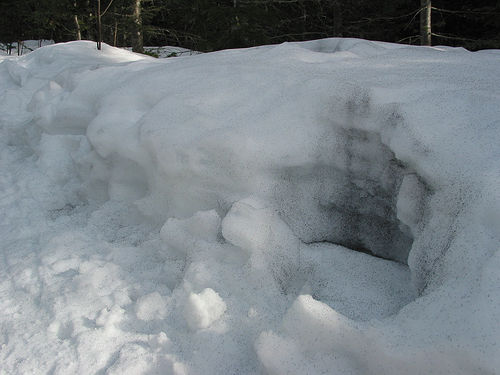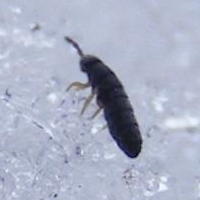Snow fleas: helpful winter critters
 As the Northeast of the United States was hammered by thundersnow this week, students, parents and perhaps those working from home had the opportunity to indulge in outdoor winter activities. For many, being in the snow again is losing its luster. As an Associated Press article noted, “The Northeast has already been pummeled by winter not even halfway into the season. The airport serving Hartford, Conn., got a foot of snow, bringing the total for the month so far to 54.9 inches and breaking the all-time monthly record of 45.3 inches, set in December 1945.”
As the Northeast of the United States was hammered by thundersnow this week, students, parents and perhaps those working from home had the opportunity to indulge in outdoor winter activities. For many, being in the snow again is losing its luster. As an Associated Press article noted, “The Northeast has already been pummeled by winter not even halfway into the season. The airport serving Hartford, Conn., got a foot of snow, bringing the total for the month so far to 54.9 inches and breaking the all-time monthly record of 45.3 inches, set in December 1945.”
However, those who are venturing outside might discover that snow forts and shovels are not the only things littering the fresh snow. At close examination, perhaps in melting snow around the base of a tree, tiny black flecks might be found sprinkled in the snow. They probably look like bits of dirt at first glance, but they are actually tiny soil animals known as snow fleas. Officially, they are called springtails and are not actually fleas (or even technically insects).
On any given summer day, hundreds of thousands of springtails can populate one cubic meter of top soil; at 1-2 mm, they largely go unnoticed by people. In the winter, however, two species of dark blue springtails— Hypogastrura harveyi and Hypogastrura nivicol—can be easily spotted against the white backdrop of snow. These hexapods may have acquired the nickname of snow fleas due to their ability to jump great distances, a feat fleas boast as well. Whereas fleas use enlarged hind legs, springtails have a tail-like appendage called a furcula that unfolds to launch the hexapods great distances.
 But unlike fleas, springtails are not parasites; they feed on decaying organic matter in the soil (such as leaf litter) and, therefore, play an important part in natural decomposition. Snow fleas in particular are able to withstand the bitter temperatures of winter thanks to a “glycine-rich antifreeze protein,” as reported in a study published in Biophysical Journal. The protein in the snow fleas binds to ice crystals as they start to form, preventing the crystals from growing larger.
But unlike fleas, springtails are not parasites; they feed on decaying organic matter in the soil (such as leaf litter) and, therefore, play an important part in natural decomposition. Snow fleas in particular are able to withstand the bitter temperatures of winter thanks to a “glycine-rich antifreeze protein,” as reported in a study published in Biophysical Journal. The protein in the snow fleas binds to ice crystals as they start to form, preventing the crystals from growing larger.
In addition, by isolating this protein, researchers have been able to study the medical potential of its structure. Specifically, Brad Pentelute from the University of Chicago and colleagues suggested the possible applications of this protein in safely preserving organs for human transplantation.
LIN, F., GRAHAM, L., CAMPBELL, R., & DAVIES, P. (2007). Structural Modeling of Snow Flea Antifreeze Protein Biophysical Journal, 92 (5), 1717-1723 DOI: 10.1529/biophysj.106.093435
Photo Credit (distance snow fleas): Jean-Sébastien Bouchard
Photo Credit (snow flea close-up): Daniel Thompkins
As the Northeast of the United States was hammered by thundersnow this week, students, parents and perhaps those working from home had the opportunity to indulge in outdoor winter activities. For many, being in the snow again is losing its luster. As an Associated Press article noted, “The Northeast has already been pummeled by winter not even halfway into the season. The airport serving Hartford, Conn., got a foot of snow, bringing the total for the month so far to 54.9 inches and breaking the all-time monthly record of 45.3 inches, set in December 1945.”
However, those who are venturing outside might discover that snow forts and shovels are not the only things littering the fresh snow. At close examination, perhaps in melting snow around the base of a tree, tiny black flecks might be found sprinkled in the snow. They probably look like bits of dirt at first glance, but they are actually tiny soil animals known as snow fleas. Officially, they are called springtails and are not actually fleas (or even technically insects).
On any given summer day, hundreds of thousands of springtails can populate one cubic meter of top soil; at 1-2 mm, they largely go unnoticed by people. In the winter, however, two species of dark blue springtails— Hypogastrura harveyi and Hypogastrura nivicol—can be easily spotted against the white backdrop of snow. These hexapods may have acquired the nickname of snow fleas due to their ability to jump great distances, a feat fleas boast as well. Whereas fleas use enlarged hind legs, springtails have a tail-like appendage called a furcula that unfolds to launch the hexapods great distances.
But unlike fleas, springtails are not parasites; they feed on decaying organic matter in the soil (such as leaf litter) and, therefore, play an important part in natural decomposition. Snow fleas in particular are able to withstand the bitter temperatures of winter thanks to a “glycine-rich antifreeze protein,” as reported in a study published in Biophysical Journal. The protein in the snow fleas binds to ice crystals as they start to form, preventing the crystals from growing larger.
In addition, by isolating this protein, researchers have been able to study the medical potential of its structure. Specifically, Brad Pentelute from the University of Chicago and colleagues suggested the possible applications of this protein in safely preserving organs for human transplantation.